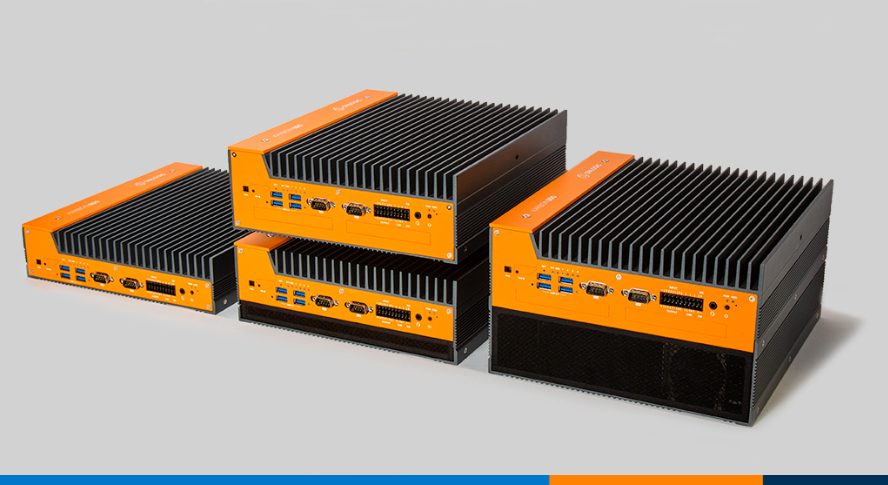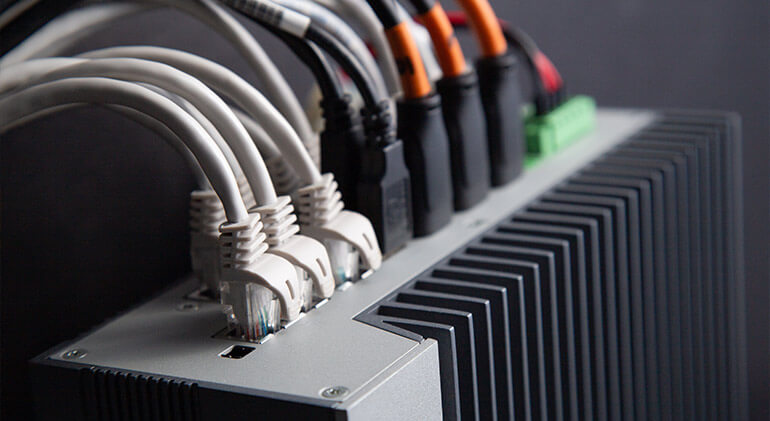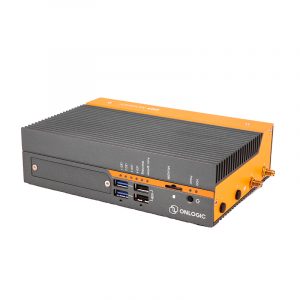Karbon Series: In-Vehicle Computer
Common features of an in-vehicle computer
An in-vehicle computer requires more features than a traditional desktop PC can deliver. In-vehicle computation at the edge requires you to consider factors such as: operating temperature, impact forces/vibration ratings, in-vehicle power, and automotive industry specific feature requirements. OnLogic offers many rugged fanless PCs such as our Karbon Series specifically engineered to overcome the challenges associated with in-vehicle computer deployments. So what are some common features to look for in an in-vehicle computer?
CAN Bus: The standard for device communication in-vehicle
When considering an in-vehicle application, you may have a need for I/O to interface with your vehicle or sensors. CAN bus is a common in-vehicle and industrial equipment communication standard that allows PCs and microcontrollers to communicate with each other in conjunction with the brains of the vehicle, the Electronic Control Units (ECUs). In modern vehicles this can include the engine, airbags, audio systems, sensors, and various other electronics. In many applications, CAN bus communication is critical to the function of your technology solution and a vital connection to account for in any in-vehicle computer. OnLogic offers several systems that can be configured with CAN bus.
In-vehicle computer example: fleet management
Let’s say you are in charge of developing a fleet management solution for a food truck company. By interfacing with the vehicle through CAN Bus to gather telematics information, you could create an application for predictive maintenance. This would allow you to bring trucks in for repair before they break down in the field. You can pair your OnLogic in-vehicle computer with an integrated 4G LTE Modem so data can easily be aggregated and sent back to your server remotely. Many businesses looking to do predictive maintenance at the edge will pair OnLogic hardware with an existing cloud solution such as AWS Greengrass. With built-in tools for machine learning, AWS Greengrass enhances these predictive maintenance applications such as edge machine learning inference, and connectors to common communication protocols such as CAN Bus.
Most OnLogic Karbon systems can come equipped with a 3-pin CAN 2.0B port, directly programmable through the onboard microcontroller. Need more than 1 port? Talk to our solutions team for additional options for expansion.
Power over ethernet (PoE): bring “vision” to the edge
Besides interfacing with the vehicle itself, many applications require the vehicle to observe what’s happening around it. This is important because vehicles do not exist in isolated environments.
Some customers look at USB-based cameras for their solution, but those bring their own set of problems when it comes to ruggedization and reliability. Traditional LAN cameras are a better fit for in-vehicle applications, but they present a problem – how do you power the camera? Power over Ethernet (PoE) LAN solves this by adding a power layer to the existing data layer of the ethernet cable. You no longer have to provide separate power to the camera, as power is provided by the PoE-enabled PC or PoE switch.
For example, an autonomous floor cleaning robot company uses 3 PoE cameras paired with a LiDAR sensor to navigate around the offices they clean. Those sensors run back to the internal OnLogic PC which does the vision inferencing and real time decision making. Most OnLogic Karbon systems can be configured with PoE or PoE+ to connect PoE enabled devices.
Solve power issues with an ignition sensing PC
Another key challenge to solve with in-vehicle computing is how to power the system. Have you ever felt that panic after realizing that you accidentally left the interior lights on in your car? Coming back to a dead car battery is problematic to say the least. The potential for battery drain when the engine is off presents a risk to in-vehicle computing. We solve this problem with programmable ignition sensing capability.
Compatible PCs can be wired to the vehicle battery and when an ignition sequence is detected, the PC will start its programmed boot delay. When the vehicle is shut off, the PC detects this and starts a soft off delay which will shut the PC down after a set amount of time. Then power is completely cut to prevent battery drain. Most of these settings are easily programmable directly in the Karbon’s microcontroller.
Ignition sensing example
Let’s say you’ve developed an IoT solution for delivery drivers to know which specific packages are to be delivered to specific addresses with a connection back to AWS cloud for supervisor dashboards at the logistics command center. The drivers regularly have to turn the engine off to make deliveries at commercial addresses. OnLogic’s programmable ignition settings allow the PC to stay on and have a constant connection without interruption.
Rugged computers for the in-vehicle environment
As we’ve established, the environment for in-vehicle computing is not hospitable for a traditional desktop PC. OnLogic offers many solutions such as our Karbon series with features that work even in the toughest of environments. Wide operating temperature means that whether you have deployed your solution in Nome, Alaska or Phoenix, Arizona – you don’t have to worry about the computer failing due to very hot or very cold temperatures.
OnLogic Karbon systems are rated for impact force and vibration to IEC or MIL-STD810G standards. The system is built to last, whether you are deploying a system for data acquisition offroad in the Mojave Desert or doing autonomous vehicle testing over the potholes of your nearest major metropolitan area. Add the necessary I/O such as CAN Bus and PoE so that you can connect your sensors to make your application successful. We build our systems to order so that you can get exactly what you need, most of the time delivered in a matter of days, not months.
Our Karbon 400 Series is our Intel atom-based lightweight rugged edge computer. If you need more compute horsepower or a GPU, our Karbon 800 Series would be a good fit. OnLogic has a PC for you whether your project is autonomous passenger vehicles, industrial equipment, or purpose built vehicle solutions.
Check out some of our customer stories that show how rugged computers can be used for in-vehicle applications. For example, advanced.farm uses one of our rugged solutions for their robotic fruit harvester, Datacadabra has an innovative in-vehicle solution for improving roadside maintenance using the Karbon 700-SE, and Bear Flag Robotics has developed an autonomous tractor with a rugged computer from OnLogic.
Ready to get started on your innovative in-vehicle solution or just need an ultra-reliable PC? Talk to one of our solutions specialists today.
Editor’s Note: Inductive Automation has ended their Ignition Onboard program. Ignition licenses must now be purchased directly through Inductive Automation. While the IGN versions of our solutions are no longer available, our computers remain a great fit for use with Ignition software. Explore our recommended hardware here.
We originally posted this story on December 1, 2020. We updated the content on November 15, 2022.
Get the Latest Tech Updates
Subscribe to our newsletters to get updates from OnLogic delivered straight to your inbox. News and insights from our team of experts are just a click away. Hit the button to head to our subscription page.
Share
More Articles
OnLogic Industrial Computers
Discover OnLogic's multitude of industrial computers that will help you to advance your IoT project
Learn more at OnLogic.com
OnLogic Industrial PCs: Designed to last. Built to order. Delivered in days. Visit our online store at OnLogic.com








